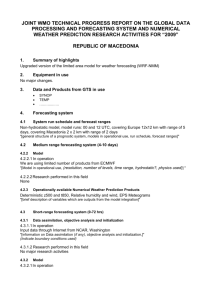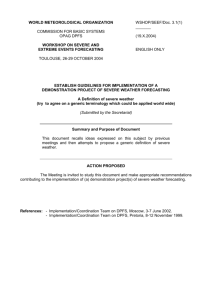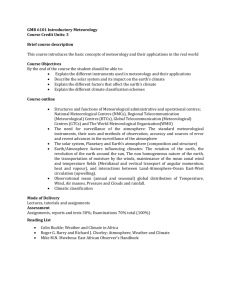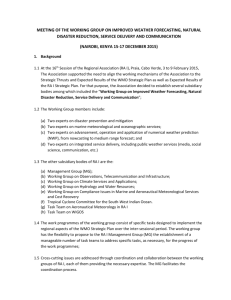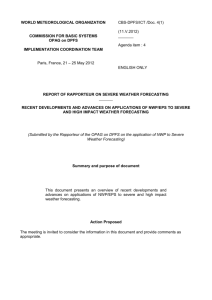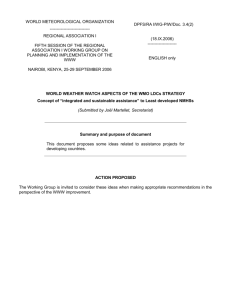RA II/WG/PIW/Doc. 4.2
advertisement
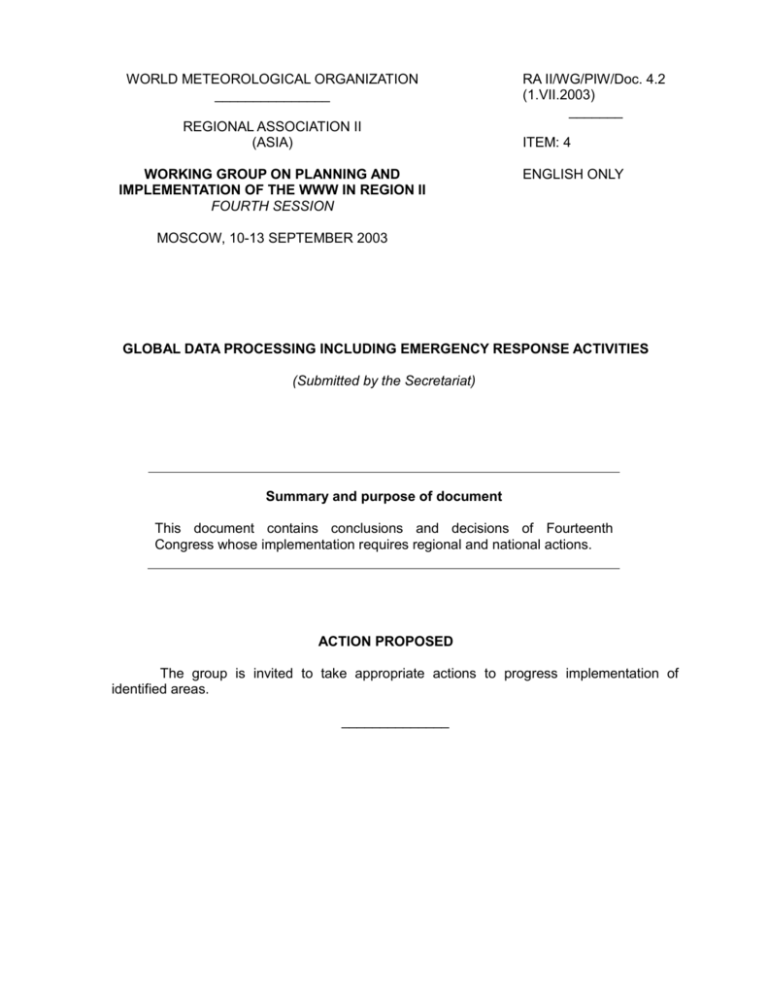
WORLD METEOROLOGICAL ORGANIZATION _______________ REGIONAL ASSOCIATION II (ASIA) WORKING GROUP ON PLANNING AND IMPLEMENTATION OF THE WWW IN REGION II FOURTH SESSION RA II/WG/PIW/Doc. 4.2 (1.VII.2003) _______ ITEM: 4 ENGLISH ONLY MOSCOW, 10-13 SEPTEMBER 2003 GLOBAL DATA PROCESSING INCLUDING EMERGENCY RESPONSE ACTIVITIES (Submitted by the Secretariat) Summary and purpose of document This document contains conclusions and decisions of Fourteenth Congress whose implementation requires regional and national actions. ACTION PROPOSED The group is invited to take appropriate actions to progress implementation of identified areas. ______________ RA II/WG/PIW/Doc. 4.2, p. 2 DISCUSSION 1. Fourteenth Congress (May 2003) encouraged Members to invest in NWP activities that were an indispensable tool for weather forecasting so as to contribute effectively to social economic development. EPS forecasting methodology and progress 2. As the amount of EPS grid fields would increase, the need for additional bandwidth in telecommunication and for software to extract information would also increase. 3. Cg-XIV urged Members to give priority to implementation and related technological cooperation activities to enhance facilities and human resources for data processing and forecasting systems and related communication services. Severe weather forecasting 4. Cg-XIV agreed that improvements of severe weather forecasting would be facilitated through the use of EPS information, other NWP products and products based on remote sensing and nowcasting tools and invited CBS to further enhance its co-ordination activities in the severe weather area. 5. To detect the outbreak of fine scale severe weather events such as tornadoes, and to anticipate their development, it was important to stress the importance of mesoscale prediction systems and nowcasting techniques. 6. Cg-XIV urged operational implementation of research results on nowcasting. Significant research was still required to improve forecasts (location and timing) of fine scale severe weather such as severe thunderstorms, tornadoes, hailstorms, downbursts. 7. Cg-XIV urged implementation and/or enhanced collaboration between the NMHSs to optimize the use of meteorological forecasts and warnings of intense precipitation in assessments of severe hydrological events such as floods, as well as rain induced landslide. It urged Members as a matter of highest priority to develop and/or enhance linkages with disaster management agencies to assure effective community response to severe weather forecasts and warnings. Emergency response Activities 8. Cg-XIV urged all Members to actively engage in the implementation of operational Internet and Web facilities in relevant NMHS facilities and services. The importance of backup operational redundancy in the implementation of such facilities was emphasized. Future priority issues included exploring use of EPS and definition of a standard set of general meteorological products to be generated for use in the interpretation of transport model products and the provision of backward trajectories to identify the origin of observed pollutants. 9. Cg-XIV supported the view that RSMCs able to do so should explore development and application of transport models to non-nuclear emergencies with a view to providing such services and contributing to capacity building of such facilities and tools in NMHSs for response to local and national scale events. Cg-XIV agreed that CBS should include those aspects as part of its future Emergency Response Activities programme. A statement of regional requirements in this area is needed with a view to giving focus to relevant future actions. RA II/WG/PIW/Doc. 4.2, p. 3 Role of NMHSs in ERA 10. Cg-XIV noted that NMHSs were a critical component of the total EER system. The NMHS role in an emergency included: monitoring alert distribution channels, defining source characteristics, notifying various agencies and other meteorological centres at the onset of an emergency, collating and interpreting meteorological data including ATM products and disseminating meteorological guidance to the local and national agencies. In addition, there were a number of ongoing maintenance functions necessary for ensuring the NMHS remained in a state of readiness for an environmental emergency. 11. Environmental emergencies, because of their relatively unexpected or ad hoc character, had the potential to generate a certain degree of confusion at their onset resulting in unacceptable delays in the preparation of a meaningful response by the various authorities. Although the response time was critical when considering human health and safety matters, a delicate balance needed to be maintained between accuracy and speed of response. Cg-XIV agreed that the timeliness of the response should be improved through ongoing development and formalization of procedures, coordinated by WMO, which would integrate and coordinate the capabilities and facilities of the NMHS and RSMC for Environmental Emergency Response (EER). 12. Cg-XIV noted that some Services were already able to issue special volcanic ash products and air pollution forecast for volcanic gas using the products based in part on atmospheric transport model using the tools of movable mesoscale models products. Cg-XIV, noting that that could contribute to assuring public health and safety, agreed that RSMCs with the operational capability to do so, should consider the development and application of such models with a view to responding to volcanic gas and other aspects of eruptions with impact on public health. A statement of regional requirements in these areas is needed with a view to giving focus to relevant future actions. Seasonal to interannual forecasts 13. Based on conclusions of WMO working and constituent bodies, Cg-XIV noted that a reliable operational global long-range forecast (LRF) system should include three different types of centres: The Global Producing Centres (GPCs); The Regional Climate Centres (RCCs); The National Meteorological Centres (NMCs) and /or Climate Centres. 14. Cg-XIV urged all Members to actively participate in co-ordinated sharing of products as either users or producers of LRF information and to provide feedback from users to production centres to improve long-range forecasting skills and contribute to the social economic development of all Members. 15. Cg-XIV urged all Members to actively participate in verification activities as either users or producers of LRF verification information to assure the use of the best available products. Regional user requirements 16. Cg-XIV noted that there was a growing interest by all regions in the utilization of NWP products, and that many Members required an opportunity for workshops or training seminars on nowcasting, EPS, and modelling. Several Members in all regions were interested in the development of a NWP system on workstations or PCs. Cg-XIV supported the development of regional approaches and strategies to address gaps in WWW infrastructure and to enhance the application of warnings, forecasts and related community response. RA II/WG/PIW/Doc. 4.2, p. 4 Training 17. Cg-XIV agreed that emphasis on training should be given to severe weather forecasting and enhanced use of EPS products and definition and response to related regional requirements. It emphasized the need to promote development and use of CAL modules on EPS and organize EPS roving seminars and workshops. 18. Capacity building activities should also include implementation of NWP models on workstations or PCs and development of packages (Web based) for specialists involved in environmental emergency response and considered to be of benefit to all active in the provision of service and interpretation of products. Conclusion 19. Statements of requirements as indicated above and regional action plan of issues raised above would give appropriate focus to future activities. ________________
